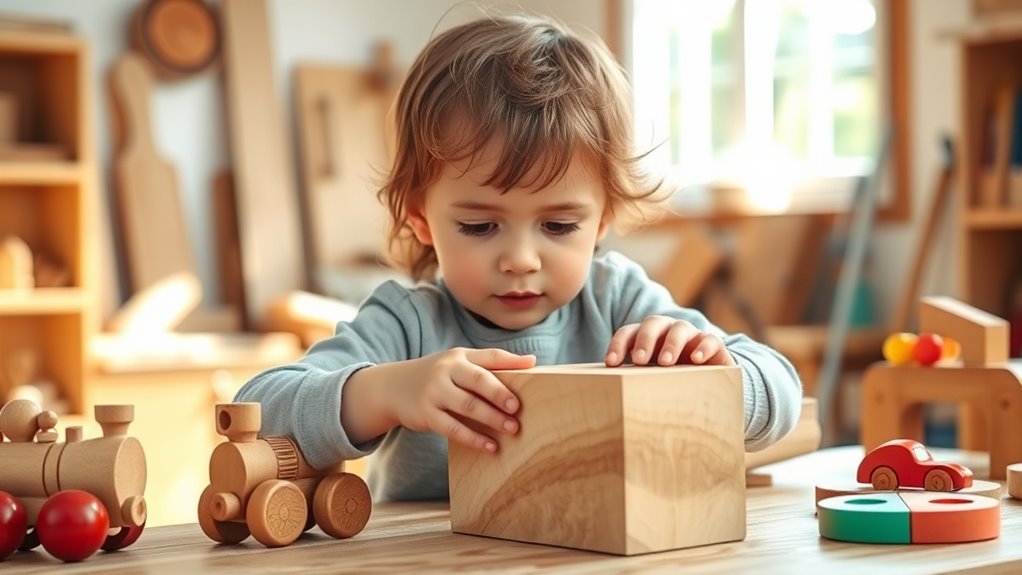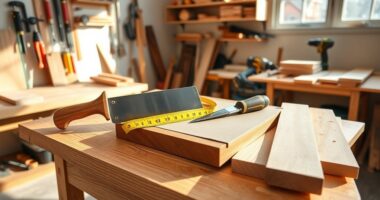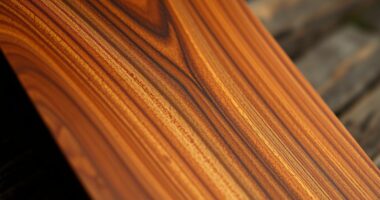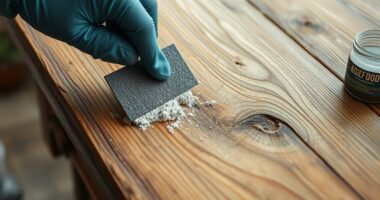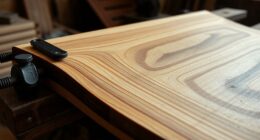Making your own wooden toys is a fun way to create safe, personalized playthings for kids. Start by choosing non-toxic, untreated woods like plywood or pine, and use safe, water-based paints. Measure carefully, sand all surfaces, and secure parts with child-safe adhesives or screws for durability. Add colorful details or details with crafts like carving or engravings to personalize each piece. Keep safety in mind during assembly and play—if you continue exploring, you’ll find tips to craft with confidence and fun.
Key Takeaways
- Use non-toxic, untreated woods and water-based paints to ensure safety during play.
- Measure, cut, and sand all parts thoroughly for smooth, splinter-free surfaces.
- Secure components with safe adhesives, nails, or screws for durability and safety.
- Personalize toys with non-toxic paints, engravings, or stickers to increase engagement.
- Regularly inspect and maintain toys, repairing or discarding damaged parts for ongoing safety.
Selecting Safe Materials and Preparing Your Workspace
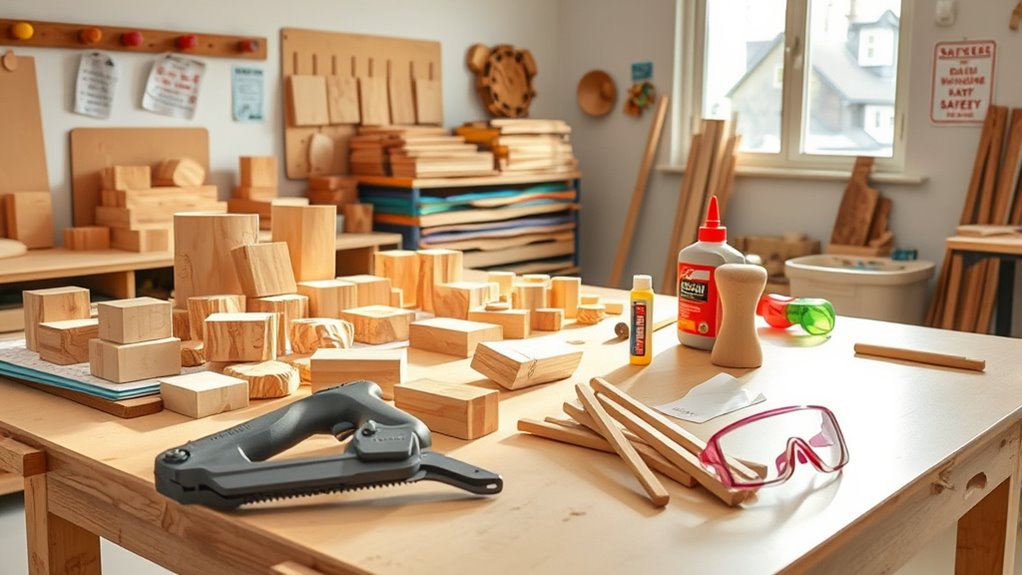
Before you start making wooden toys, it’s essential to choose safe materials and set up your workspace properly. For your DIY wooden toys, stick with non-toxic, untreated woods like plywood, pine, or beech to guarantee safety for children. When selecting materials and tools, choose age-appropriate options such as safety scissors, wide brushes, and spring-loaded pliers to avoid accidents. For finishing touches, opt for water-based, non-toxic paints and varnishes that meet toy safety standards. Organizing a well-lit, clutter-free workspace with all necessary materials and tools ready to go helps prevent mishaps and keeps your environment safe. Proper workspace setup is crucial for efficient crafting and safety. Ensuring proper ventilation in your workspace is also important to prevent the buildup of fumes from paints and adhesives, making your crafting environment safer. Additionally, using appropriate cleaning tools helps in maintaining a tidy and safe workspace. Choosing the right work surface that is durable and easy to clean can also contribute to a safer and more efficient crafting process. Whether you’re making full size or Simple Wooden toys, prioritizing safety and organization is key to successful, enjoyable crafting.
Simple Techniques for Crafting Durable Wooden Toys
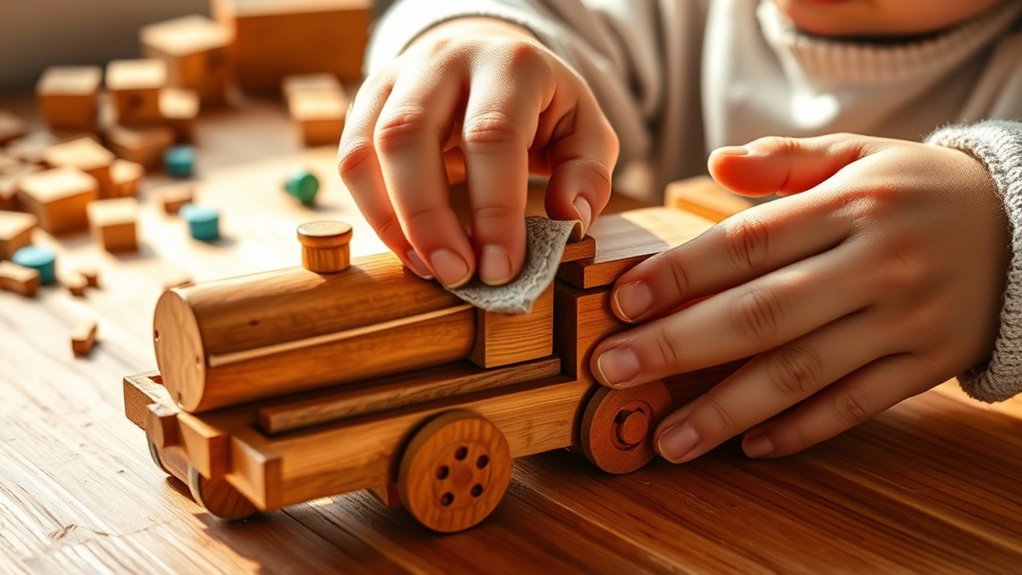
To craft durable wooden toys, focus on precise measurements and careful cutting, which lay the foundation for a sturdy final product. Accurate measurements ensure smooth assembly and prevent weak points. Use sharp tools for clean cuts and avoid splinters. Sand all surfaces thoroughly to eliminate sharp edges and splinters, enhancing safety during play. Color accuracy impacts the overall quality of painted or decorated toys, ensuring vibrant and true-to-life finishes. Secure parts with simple techniques like gluing, nailing, or screwing to ensure durability. Incorporate moving parts carefully, checking fit and function to maintain safety and longevity. Proper tool selection can make a significant difference in achieving clean cuts and safe edges. Here’s a quick overview:
| Technique | Purpose | Tip |
|---|---|---|
| Precise measuring | Ensures proper fit | Double-check dimensions |
| Sand surfaces | Removes splinters | Use fine-grit sandpaper |
| Secure assembly | Improves durability | Use non-toxic adhesives and fasteners |
Being aware of city dynamics can help you better understand how to design toys that are safe and engaging for children in different environments. Additionally, understanding safety standards ensures that your handmade toys meet necessary safety requirements, giving peace of mind to parents and caregivers.
Creative Ideas for Personalizing Handmade Toys
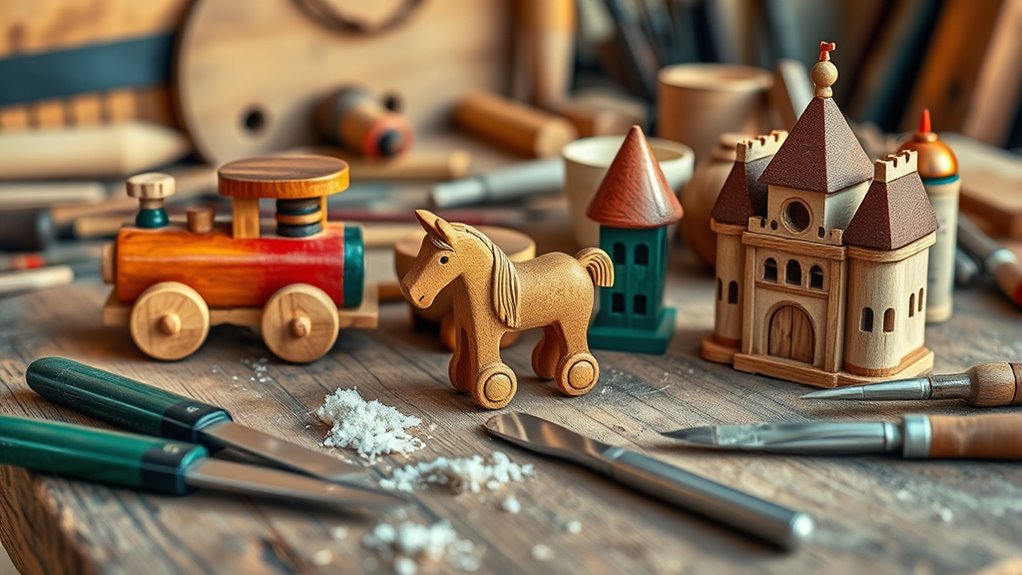
Once you’ve mastered the techniques for crafting sturdy wooden toys, adding personal touches can truly make them special. You can do this by customizing with:
Adding personal touches transforms sturdy wooden toys into unique, meaningful keepsakes and heartfelt gifts.
- Non-toxic paints, engravings, or stickers to add color and character, increasing sentimental value and uniqueness. Incorporating safe materials ensures that your personalized decorations are suitable for children’s delicate skin and health.
- Family themes or favorite colors that make toys more engaging and meaningful for your child. Exploring vibrational alignment can help you attract inspiration for designs that resonate emotionally. Using powerful design elements can further enhance the impact of your personalized touches.
- Personal details like names or symbols to transform simple toys into memorable keepsakes or thoughtful gifts.
- Incorporating craftsmanship skills can also elevate the quality and detail of your handmade toys, making each piece truly unique. Techniques such as pyrography or carving allow for intricate, one-of-a-kind designs that showcase your individual style. These personal touches not only enhance the aesthetic appeal but also create a deeper emotional connection between the child and their toy, making each piece truly one of a kind.
Tips for Ensuring Child Safety During Play

Ensuring child safety during play is essential for parents and caregivers. Always supervise children to prevent accidents with small or sharp parts that could cause injury. Make sure all finished toys are thoroughly sanded to remove splinters and sharp edges, reducing the risk of cuts. Use non-toxic, child-safe paints and finishes that meet safety standards like ASTM or EN71 to keep your little one safe from harmful chemicals. Regularly check toys for damage or worn parts, and repair or discard any compromised items to avoid hazards. Educate children on proper toy handling and storage to promote safe play habits and extend the lifespan of their toys. Incorporating sound vibrations and calming music into playtime routines can also enhance relaxation and emotional well-being, creating a more enjoyable environment for your child. Additionally, understanding interior design basics can help you create a safe and comfortable play area that promotes healthy development. To further enhance safety, consider personal empowerment techniques such as setting clear boundaries and routines, which can help children develop good habits and awareness during play. Moreover, implementing data-driven strategies in your toy selection and safety practices can maximize protection and ensure your child’s safety during play. Staying informed about child development can also guide you in choosing age-appropriate toys that support growth and learning. These precautions help create a safe and enjoyable environment for your child’s playtime.
Inspiring DIY Projects to Start Today
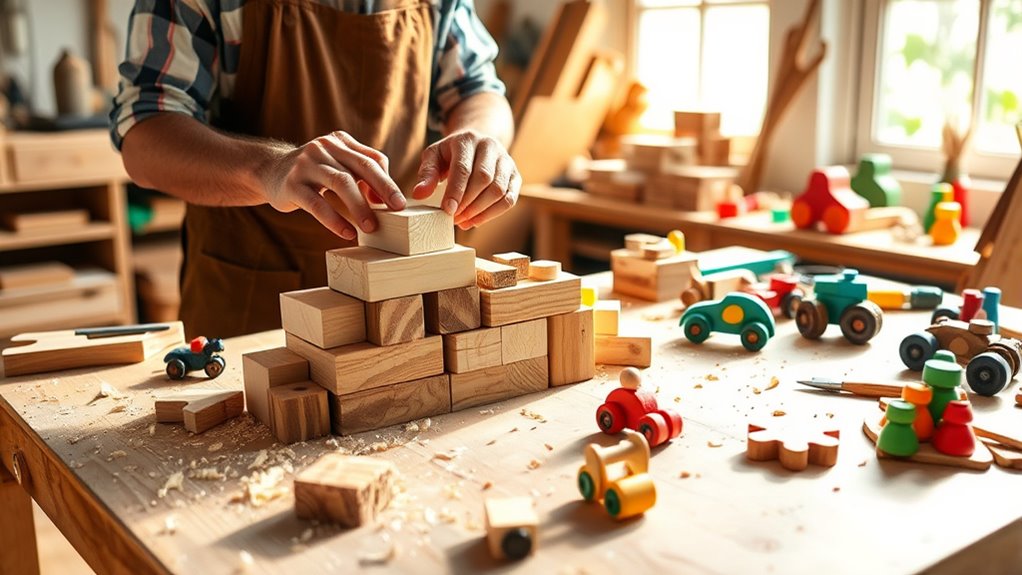
Starting your DIY wooden toy journey is both rewarding and fun, especially when you choose projects that match your skill level and interests. To get started, consider simple, colorful stacking blocks that help develop motor skills, personalized puzzles for a custom touch, or articulated animal figures that spark imagination. Here are some ideas to inspire your creativity:
Begin your DIY wooden toy adventure with colorful blocks, personalized puzzles, and imaginative animal figures for fun and skill development.
- Craft vibrant stacking blocks using non-toxic, untreated wood and water-based paints for safety. Incorporating safety standards ensures your toys are suitable for children and free from harmful chemicals. Additionally, selecting eco-friendly finishes can further promote safe play. Ensuring the proper handling of raw materials during construction can also help prevent contamination and maintain quality.
- Design personalized puzzles by measuring and cutting pieces carefully, then adding unique details. Paying attention to material safety helps prevent potential health issues from exposure to toxins.
- Make articulated animal figures that encourage imaginative play through precise assembly and sanding. Using smooth, splinter-free wood is essential for ensuring these toys are safe for little hands.
- Ensuring your wooden toys are safe involves understanding candy sugar content and avoiding the use of harmful additives or finishes that could pose health risks for children.
- When working on your projects, consider changing gears on a gravel bike to ensure smooth assembly and finishing processes, especially when handling different materials or applying finishes. Proper sanding and sealing techniques enhance durability and safety.
Frequently Asked Questions
How Do You Make Wooden Toys Safe?
To make wooden toys safe, you should choose untreated, smooth-sanded wood free of splinters and sharp edges. Use non-toxic, water-based paints and finishes that meet safety standards. Avoid small parts that could cause choking hazards, and secure all components firmly with child-safe adhesives or fasteners. Regularly inspect your toys for damage, splinters, or wear, and repair or discard them to guarantee ongoing safety during play.
Why Did Lego Stop Making Wooden Toys?
Imagine a world where tiny wooden blocks click perfectly into place, but Lego decided to switch to sleek, shiny plastic bricks instead. They stopped making wooden toys because the market favored the durable, precise plastic sets. Plus, wooden toys cost more to produce and handle logistically. By focusing on plastic, Lego keeps its brand consistent and scalable, making sure your building experience is smooth, fun, and reliable.
What Wood Is Safe for Children’s Toys?
You’re wondering what wood is safe for children’s toys. Opt for untreated hardwoods like maple, beech, and birch, which are durable and non-toxic. Softwoods like pine and cedar are also safe when untreated and chemical-free. Avoid woods with chemicals, preservatives, or finishes. Always choose smooth, splinter-free, knot-free wood, ideally certified or food-grade, to guarantee safety and prevent injuries during play.
Can You Make Money Making Wooden Toys?
Yes, you can make money making wooden toys. With the right skills and quality craftsmanship, you can sell your toys online or locally, earning a healthy profit margin of 30-50%. Focus on unique, personalized designs and effective marketing to attract buyers. Your initial investment in tools and materials will likely be recouped quickly, making this a profitable side business that combines your creativity with earning potential.
Conclusion
By choosing safe materials, honing your techniques, and adding personal touches, you create toys that are both fun and safe for your little ones. Remember, a well-made toy is worth its weight in gold, and the effort you put in shows. With patience and creativity, you’ll turn simple wood into cherished treasures. So, don’t be afraid to roll up your sleeves—your next masterpiece is just a project away!
